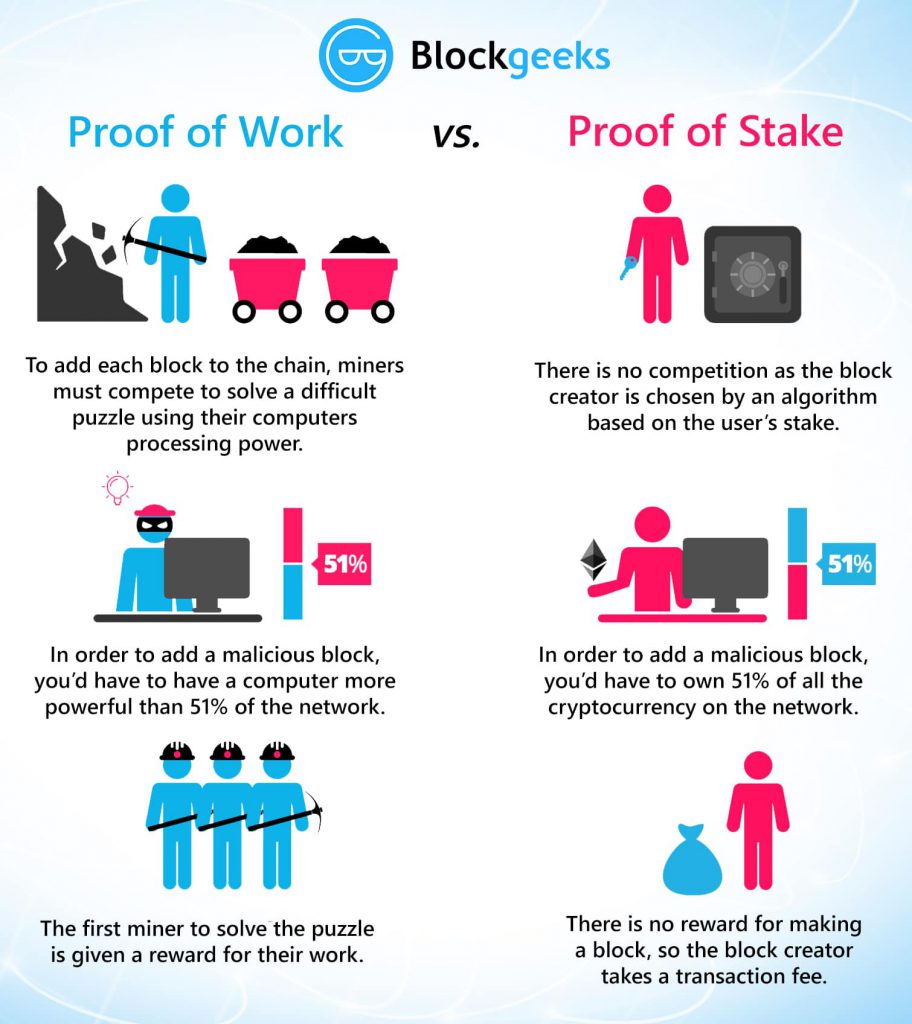Cryptocurrencies are powered by blockchain technology, and blockchain technology is dependent on consensus protocols to secure and validate transactions. Consensus protocols are basically a set of rules that miners have to obey in order to keep a network running and guard the blockchain against cybersecurity attacks.
In the cryptocurrency space, two of the most well-known and widely used consensus protocols are Proof of Work (PoW) and Proof of Stake (PoS).
Bitcoin uses PoW, whereas Ethereum, now also using PoW, will be shifting to PoS sometime in the near future.
Here’s an explainer about the difference between PoW and PoS:
Proof of Work

PoW, as its name suggests, is a consensus protocol where miners have to prove that they literally “put in the work” to validate a cryptocurrency transaction. They do so by utilizing hardware that consumes vast amounts of electricity.
In this process, miners and their hardware have to complete computationally difficult mathematical equations called hashes. Once an equation is solved, a hash is produced, and other miners participating in the PoW network will be able to view the hash to verify whether or not it is legitimate. Miners are subsequently rewarded with cryptocurrency — in this case, Bitcoin — for their efforts.
Proof of Stake

PoW requires high computational power, and is thus not the most environmentally friendly consensus protocol. Ethereum creator Vitalik Buterin conceived of the PoS consensus protocol as a more energy-efficient alternative to PoW.
Rather than spending high costs on purchasing hardware that consumes high levels of electricity, miners in PoS “stake” their cryptocurrencies onto a network; they are then assigned mining capacity that is proportionate to how much cryptocurrencies they put onto the network.
In the Ethereum blockchain, miners are instead seen as “validators”. Validators are required to possess at least 32 Ethereum coins (ETH) in order to have the right to validate transactions. This means that, for example, if a validator holds 32 ETH and the total number of ETH in circulations is 160 ETH, he will be able to validate 20% of the Ethereum blocks.

In addition, instead of receiving block rewards like Bitcoin, validators receive transaction fees at the end of each validation process. If a validator verifies a faulty or suspect transaction, he risks losing a portion of his stake.
This proportional distribution model also means that PoS significantly reduces the computational power needed when mining for cryptocurrencies. Many also argue that the minimum 32 ETH requirement lowers the barrier for entry into the PoS network; instead of investing a large amount of money to purchase mining equipment like PoW, miners can begin with low-cost hardware to start accumulating ETH.
As of now, only altcoins — i.e. cryptocurrencies other than Bitcoin — use PoS, including Cardano and Algorand.
Which Is Better?

In terms of energy consumption, PoS is generally seen as the more energy-efficient consensus protocol compared to PoW and is thus sometimes touted as the “future” of blockchain development.
PoS is also more scalable than PoW. This is because in PoW, the speed in which transactions can go through depends on two factors: (i) block time, i.e. the time required to create a new block in the blockchain; and (ii) block size, i.e. the amount of data that can be stored in each block.
A block on Bitcoin is mined approximately 10 minutes. Next, Bitcoin’s block size is 1MB. This means that under Bitcoin’s PoW, a block can only “fit” 1MB of data for each transaction; any transaction that misses the chance to “fit” into a block under PoW has to be put on hold and “wait” for a new block to be mined. This is time consuming.
PoS, on the other hand, runs a protocol called “sharding“, where blocks are “split” into smaller networks and each network runs its own validation process instead of network-wide validations for each transaction like in PoW. This speeds up transactions on the blockchain. In short, PoS offers faster transaction speeds and higher output, and beats PoW in productivity.
However, in terms of security, despite its excessive maintenance costs and enormous environmental damage, Bitcoin’s PoW remains one of the most attack-resistant consensus protocols in the blockchain space. Because of this, the Bitcoin community has no plans to shift from PoW to PoS. Technical and logistic complexities that entail are also pull factors that explain why Bitcoin miners and developers still prefer PoW.
Regardless, both PoW and PoS have their strengths and weaknesses, and the decision to adopt either consensus protocol depends on a cryptocurrency’s use case.
Also Read: Ethereum’s Upcoming Ethereum Improvement Proposal (EIP), The EIP-1559, Explained



































